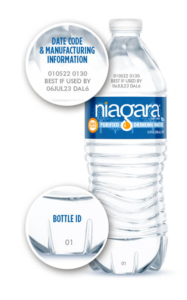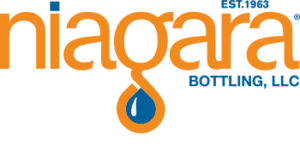Purified Drinking Water: Sourced from either deep protected wells or from municipal water supplies. This water is purified through microfiltration and reverse osmosis which removes the salts, minerals, and any suspended solids from the water. Niagara® also incorporates ozone contact systems to disinfect their drinking water and ensure the highest quality product.
Purified Drinking Water with Minerals Added: Processed in the same manner as purified water then has a defined mix of minerals added back.
Alkaline: Products are made using a similar process as purified drinking water with minerals added; however, there is an additional electrolysis step to increase the pH.
Spring Water: Water is obtained from protected spring sources approved by our quality team before being brought to our bottling facilities. We then use microfiltration and ozone to disinfect the water while making sure that no minerals are removed.
Distilled Water: Water purified by reverse osmosis, then distilled to remove virtually all traces of mineral content. The water is then disinfected with ozone.
The typical shelf life for each product is as follows:
Purified Water, Purified Water with Minerals, Spring Water and Distilled Water: 547 days.
Alkaline: 730 days.
Niagara® Sparkling: 270 days.
To find the specific “Best If Used By” date on your product, please refer to the date etched into the bottle, just above the label.
Purified and alkaline water have very small amounts of food-grade minerals that are added strictly for taste and have no nutritional value.
Spring water mineral content is specific to the spring source and varies depending on the location of the spring.
Distilled water removes all traces of mineral content through the distillation process.
Check the label on your Niagara® bottled water bottle for specific minerals that were added. You can also check out our Water Quality Report for more information regarding mineral content.
Each bottle of water begins with a carefully selected well, spring or municipal water source. The water is initially processed using a multi-step filtration process. Next, the water is purified using a reverse osmosis or distillation system and then it is disinfected with ozone just prior to bottling.
Providing great tasting spring water starts with finding the best tasting, highest quality source. All spring sources undergo an intense audit and review before being selected. The sources are inspected by our trained and experienced Quality Assurance staff, which includes microbiologists, chemists, and hydrogeologists. During the inspection process, all aspects of the source are examined including security, treatment at the source, water chemistry, and environmental impact. Once a spring is approved for use, the spring water is collected and then loaded onto dedicated water tankers and delivered to our bottling facilities. Water is tested at our facility to ensure quality and safety prior to use. It is then filtered down to 0.2 microns and disinfected with ozone just prior to bottling.
Reverse osmosis is a process that removes nearly all of the salts or minerals in the source water. Reverse osmosis works by forcing water through a semipermeable membrane at high pressure and is a very effective method for purification.
Micron filtration removes sediment and suspended particles. These filters are designed to remove particles as small as 0.2 micron in diameter.
Please view this video to learn more about our multi-step quality process.
For purified and distilled products, any sodium in the source water is removed in the purification process.
For purified drinking water with minerals, the sodium content is approximately 1mg per 16.9 oz. Please view our Water Quality Report for more information.
Fluoride is often added to municipal water supplies, but it is generally not added to bottled water products. Spring water may contain natural fluoride levels. Fluoride in the source water is removed in the purification process for all of our purified and distilled bottled water. To learn more about our water, please view our Water Quality Report.
Spring water, purified drinking water and purified drinking water with minerals have a pH of less than 8.0. Alkaline water has a pH of greater than 9.0 at the time of bottling.
Our bottled water samples are tested daily in each facility’s quality laboratory using calibrated pH meters. To properly test the water, we use a calibrated pH meter with an attached high purity pH probe at the time of bottling. A calibrated pH meter is an electronic instrument used to measure the pH (acidity or alkalinity) of a liquid. This specialized equipment is the only way to obtain an accurate pH result from high purity waters and help to ensure that the water produced meets the strict quality specifications defined for these bottled water products.
Our bottled water products typically have a total dissolved solids less than 60ppm, keeping it well below the ability of a pH strip to provide an accurate reading. Litmus papers or test strips will NOT test accurately on high purity bottled water products.
We do not use or add BPA to any of the materials used in any of our bottled water containers. BPA (Bisphenol –A) is a chemical building block used primarily to make polycarbonate plastic and epoxy resins.
All of our bottles are produced using PET (polyethylene terephthalate) plastic and high-density polyethylene (HDPE) caps. These are food grade plastics that are approved by the U.S. Food and Drug Administration for their use in many types of food containers.
To learn more about our water, please view our Water Quality Report available in both English and Spanish.
Our on-site testing laboratories are equipped with state-of-the-art testing machinery and staffed with degreed, experienced personnel. Comparative analyses are performed daily on products in accordance with state and federal regulatory standards. We test for organic chemicals and inorganic chemicals as regulated by the FDA and some individual states.
Our bottles are filled under sanitary conditions and are disinfected during the production process. Freezing the bottle is harmless to the product. However, as water freezes, it expands and will distort the shape of the bottle causing instability. It may potentially expand through the cap and break the seal.
The International Bottled Water Association (IBWA) advises consumers to store bottled water at room temperature or cooler, out of direct sunlight, and away from solvents and chemicals such as gasoline, paint thinners, household cleaners and dry cleaning chemicals.
Our bottles and caps are 100% recyclable*. Please empty and replace cap prior to recycling. To learn more about where you can recycle your bottle, visit How2Recycle.info.
*Excludes label and outer packaging, which may not be recyclable in your area.
In the past 15 years, we have reduced the amount of plastic in our Eco-Air® Bottle by over 60% versus our original 1998 500mL bottle. Because of the reduced weight in our plastic, we can:
- Transport more water per truckload which reduces CO2 emissions
- Use less plastic per bottle which helps conserve valuable resources
- Since 2009, Niagara® has reduced the carbon footprint of its bottles by 59% through innovations in design, lightweighting, and packaging.
In addition, we’ve reduced our label size and bottle cap size to further reduce our material use. Learn more about our packaging efficiency here.
Niagara® is committed to responsible resource usage and integrating sustainability into every aspect of our business. Learn more about our sustainability efforts here.
Click here to find Niagara® branded water at a store near you.
For all sales inquiries, please email sales@niagarawater.com.
According to the FDA, there is not sufficient scientific evidence to show that microplastics and nanoplastics from plastic food packaging migrate into foods and beverages. Current scientific evidence does not demonstrate that levels of microplastics or nanoplastics found in foods pose a risk to human health. Many of the scientific studies have used methods of variable, questionable, and/or limited accuracy and specificity. Please reference this link to learn more about how the FDA keeps bottled water safe to drink.
 English
English Español
Español
